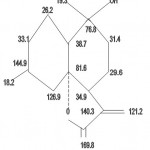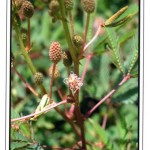How to Cite | Publication History | PlumX Article Matrix
Effect of Sesquiterpene Lectone on the Control of Callosobruchus chinensis Linn.
R. K. Diwan and R. C. Saxena
Pest control and Ayurvedic Drug Research Laboratory, S.S.L JAIN P.G. College Vidisha India
Corresponding Author E-mail: rcsvds@yahoo.comABSTRACT: Sphaeranthus indicus which is known as "Gorakhmundi" is a medicinal plant which is also used as insecticides. 2500 ppm concentration was found to inhibit feeding to Callosobruchus chinensis rared on Cicer arietinum seeds. The plant extract when examined chemically gave a Sesquiterpene lectone which is responsible for phagodeterrant activity.
KEYWORDS: Callosobruchus chinensis; phagodeterrant; Sphaeranthus; Sesquiterpene
Download this article as:| Copy the following to cite this article: Diwan R. K, Saxena R.C. Effect of Sesquiterpene Lectone on the Control of Callosobruchus chinensis Linn. Biosci Biotechnol Res Asia 2008;5(2). |
| Copy the following to cite this URL: Diwan R. K, Saxena R.C. Effect of Sesquiterpene Lectone on the Control of Callosobruchus chinensis Linn. Biosci Biotechnol Res Asia 2008;5(2). |
Introduction
Insect pests infects heavy loss to the stored food grains specially tropical and sub tropical continents. Therefore, there is a need for developing diverge kind of safe insecticides may be either repellent or phagodeterrant to be used against stored food grains pests. Feedingdeterrants are those chemicals which are either essential oils or terpenoids like secondary metabolites found in the variety of angiosperm plants.
Tripathi et al (2000), have reported the volatile constituent of Mentha species against Callosobruchus maculatus and Tribolium castaneum. Many plant compounds have been reported by Brattsten (1988), as insecticides or phagodeterrant against variety of stored grain pests.Templeton (1969) have given detail study of Terepenoids and Steroids. Similarly, Mishra (1984),have reported pulse grain protectant activity of mentha powder against Callosobruchus chinensis .In the present laboratory also lot of work have been carried out on plant products as protectants, repellant as well as phagodeterrant Saxena et al (1992),have discovered the insecticidal activity of Lantana camara against Callosobruchus Chinensis . Similarly, Dixit and Saxena (1990), have reported the insecticidal activity of Primina integrifolia against Callosobruchus chinensis.
The present paper reports the isolation of sesquiterpene lectone from Sphaeranthus indicus of compositae family commonly known as “Gorakhmundi” against Callosobruchus chinensis infested Cicer arietirium in the stored houses.
Material and Methods
Collection and Exatraction of Plant Material
For the present study Sphaerathus indicus of family composite have been collected usually from the bank of river Betwa. The aerial parts of the plants were shade dried at room temperature and powdered material of 40-60 mesh size was “Soxhlated” in Petroleum ether, acetone, methanol, alcohol and water respectively. The percentage yield was calculated in each solvent. The crude was vacuum evaporated to dryness under reduced pressure. The semisolid crude extract was purified using chromatography and TLC respectively which gave four fractions in petroleum ether extracts. Fraction I found biologically active as feedingdeterrent, hence, used for experimental bioassay.
Stastical Methods
‘Chi-square test’ and Finney (1971), method of ‘Probit analysis’ was used for the stastical evaluation of experimental data.
Biological assay methodology
The following screening tests were carried out. Insecticidal activity of the plant extract,0.4 ml of each extract at the different concentrations was poured into clean, grease free glass tube of 100ml capacity and a uniform film of the extract was made by rolling the vials. Freshly emerged adults (25) were then released in each of the treated vials which were covered with piece of Muslim cloth held by rubber band to prevent escape of the adults. Untreated healthy grain seeds, were provided to the adults during the bioassay.
Observations on insecticidal activity were made at 1, 3, 5 and 7 days after treatment.
Antifeedant Activity
0.5ml of each extract at three different concentration was poured into glass vials of equal volume containing 20 healthy grain seeds. Before being placed in the vials, the seeds were kept for 24 hours in an oven at 70◦c.
The solvent were allowed to evaporate completely before release of five pair of freshly emerged adults in a vial. Two controls were maintained one in solvent treated vial and the other without any treatment .The number of damaged seeds were recorded daily for 7 days, period and the damage was noticed.
Table 1: Feeding extent by grubs of Callosobruchus chinensis on treated Cicer arietenum.
| EXTRACT
DAMAGED % |
CONCENTRATON
|
FOOD
|
| ppm. | ||
|
4th 5th 7th |
|
1st 2nd 3rd
|
| Sphaeranthus indicus | ||
| (family compositae) | ||
| 1. Acetone extract
– 2.0 7.0 |
1000
|
– – –
|
|
– – 5.0 |
2000
|
– – –
|
|
– – – |
2500
|
– – –
|
| 2. Petroleum ether
2.0 3.0 6.0 extract – – – – 7.0 |
1000
2000
|
– – –
–
|
|
– – – |
2500
|
– – –
|
| 3. Methanol extract
5.0 8.0 10.0 |
1000
|
– – –
|
|
– 4.0 7.0 |
2000
|
– – –
|
|
– – – |
2500
|
– – –
|
In control the seed was 42.0 and 41.0% during the period(p<.005)
Observations and Results
Isolation of biologically active compound :Chromatographic separation
The biologically active compound was separated by chromatography on columns (10×62 cm)of silica gel (60-120 mesh) successive elution with hexane, petroleum ether (40-600) and benzene removes fatty materials, carotenoids and phytosteroids, respectively. Further elution with ethyl acetate yielded fraction I contaminated with chlorophylls was removed by treatment with active charcoal and the concentrated extract (fraction II) rechromatographed on a small (4x40cm) columns of silica gel. Elution with benzene, ethyl acetate (9:1) yielded fraction III from which the biologically active principle was separated by preparative layer chromatography (PLC) . TCL was performed on 0.25 mm layers of silica gel G using benzene: ethyl acetate (85:15) as the developing solvent. Preparative layer chromatography was performed on 1mm layer of silica gel G using benzene methanol (90:10: one drop MeOH) as developing solvent.
Analytical Techniques
IR spectra were determined in ccl4 solution using Perkin Elmer Model 783, while UV spectra were determined in ethanol using a Cary -14 spectrophotometer (Varian).
1H and 13 C-NMR spectra were run in CDcl3 on JEOL FT-NMR spectrometer operated at 90 MHz. The important spectral values of the compound (I) are given below-
IR:-KBr (ccl4) cm-1 3440, 2920, 920, 850.
UV:-242 mm.
1H-NMR: methyl proton at δ1.06, 1.75 methylene and methane protons at δ 1.25, 1.55, 2.0 olefinic protons
at δ 5.05, 5.71, 6.12 and an hydroxyl proton at δ 3.4.13C-NMR(see I)
MASS:-M+ 248 and other important fragments ions at 233(Base peak ) 215, 186, and 168.
Isolation of Biologically Active Principles
The petroleum ether extract was purified by the chromatographic procedure. Thin layer chromatography of fraction II showed two characteristic bands under UV light (242nm) which gave positive phosphomolybdic acid tests.Final purification was achieved by preparative TLC. (Four times) of fraction III which yielded a colorless glassy compound (I) yield.0.0075%.
Identification of compound (I)
The compound showed IR bands(ccl4) at 3440(OH), 1750 and 1640(α, β,-unsaturated γ-lactonic group containing an exacyclic double bond). UV maximum at 242nm confirmed this. Mass spectra displaying 248(M+) and other fragment ions at m/e 233, 215 supports molecular formula C15H20O3. The 1H-NMR spectrum showed two methyl groups at δ 1.06(S,3H)and 1.75 (S,3H), terminal metheleneprotons at δ 5.71(S,1H) and 6.12 (S,1H).The third olefinic proton displayed a signal at δ 5.05(S,1H) and the hydroxyl proton prepared at δ 3.4(bs,1H).
 |
Scheme 1
|
These data, in conjunction with the isoprene rules suggest the structure for the principles as shown in Fig (I). The results of 13C-NMR shown on the structural formula are also consistent. A more detailed chemical analysis will be published elsewhere.
Feeding deterant Activity
Sesquiterpene lectone isolated from Sphaeranthus indicus have shown phagodetent activity with Callosobruchus chinensis. The results as indicated in table 1 shows that 1000 ppm concentration of acetone extract was quite effective upto 4th day treatment.
There was total 7% damage of food in the treated seeds. 2000 ppm concentration showed feeding deterrancy by the grubs upto 5th day of treatment .There after, there was only 5% damage of seeds of Cicer areitinum on 7th day period. 2500 ppm conc. was found to be quite effective causing complete inhibition of feeding .
The petroleum ether extract was less effective than the acetone and methanolic extracts.
The results when compared by T test value, it was found quite significant at 5% level.(p<0.005) . The acetone extract fraction of sphaeranthus indicus was further purified and structural elucidation was carried out using chromatographic techniques. Finally, the phagodeterrant principles was determined comparing with the authentic marker of Sesquiterepen obtained from Brazil as gratis.
Antifeedent activity of various indigenous products have been reported by Saxena et al (1999); Parsad et al (2000), Jotwani and Shrivastava, (1981), who have noticed the grain protactant activity in Neem seed kernel. Saxena(1992 ) ,have reported the insecticidal activity of lantana camara against Callosobruchus chinensis .The insecticidal and antifeedant activity in the Sphaeranths indicus as reported in the present study is quiet comparable with the activities of larvicidal and antimicrobial by Sharma and Saxena (1996), & Singh et al (1988.).
 |
Photograph 1: Photograph of Sphaeranthus indicus.
|
Acknowledgement
Authors are thankful to the Deptt.of Higher education Govt. of Madhya Pradesh for permitting one of the author (R. K. Diwan) and to the Head S. A. I. F., C.D.R.I. Lucknow for spectral analysis of the compound.
References
- Brattsten L.B., (1983). Cytocrome p-450 involvement in the interaction between plant terpenes and insect herbivores. P.A.Hedin(ed.) plant resistance to Insects.PP 173-195 American chemical society, Washington.
- Charlwood B.V. and K.A. Charlwood (1991). Monoterpenoids in B.V. Charlwood and D.V. Banthope(eds.) Methods in plant Biochemistry, vol.7 Terpenoids, pp 43-98 Acadmic, London.
- Dixit O.P. and R.C. Saxena (1990 a).Insecticidal action of Primina integrifolia against Callosobruchus chinensis (Coleoptera-Bruchidae)Pesticides,24; 21:29.
- Dixit O.P. and R.C. Saxena (1990 b). Antiovipositional effect of Adhatoda vasica leaf extract against two species of Callosobruchus chinensis. Geobios News Reports 9:76-77.
- Finnay D.J. (1971). Probit analysis 3rd ED.Cambridge University. Press London .pp 318.
- Tripathi Arun kumar, Veena Prajapathi, Krishna kumar Agrawal, Sushil Kumar;(2000).Effect of volatile oil constituents of Mentha species stored grain pests, Callosobruchus chinensis and Tribolium castaneum.Jr. of medicians and Aromatic plant sciences 22(2000) 549-556.
- Jotwani M.G. and K.P. Shrivastava (1981). Neem kernel powder as grain protactant in wheat storage. Pesticides 15:19-23.
- Karr L.L. and J.R.Coasts (1988). Insecticidal properties of dlimonene, J. Pesticides sciences, 13:287-290 .
- Mishra R.C., Mosih D.B. and P.R.Gupta (1984). Effect of mixing mentha powder giving oil in water emulsion dip to the chickpea on pulse beetle, Callosobruchus chinensis Linn, Bull Grain Tech 22:19-24.
- Prasad Rajendra, Yalamanchilli and Baby Punukollu (2000). Bioefficacy studies on leaf oil of Curcuma domestica Valeton: Grain protactant activity. J. of Med and Ar.Pl.Sci.22(2000) 715-716.
- Saxena Anita, V. Harshan and R.C.Saxena (1992).Insecticidal action of Lantana camara against Callosobruchus chinensis (Coleoptera: Bruchidae).Dunker/Anglw Zoo logic 2/92(D-76/32 S)
- Saxena Shumali, Shalini Arora, Hemant Saxena and R.C. Saxena (1999). Antifeedent activity of some phytochemicals on Callosobruchus chinensis and maculatus. Him J.Env.Zool.vol. 13, (1999) pp23-31.
- Sharma Manik and R.C.Saxena (1996). Sphaeranthus indicus as a mosquito vector: J.Appl. Zool. Res. (1996) 7 (1) :87-88.
- Singh S.K., Km. Saroj, Tripathi V.J., Singh A.K. and R.H. Singh (1988). Antimicrobial principle from Sphaeranthus indicus : Int . J. crude Drug Res.26(1988),no. 4 ,pp 235-239.
- Templeton W.(1969). An introduction to the chemistry of terpenoids and steroids, Butterworths.

This work is licensed under a Creative Commons Attribution 4.0 International License.





